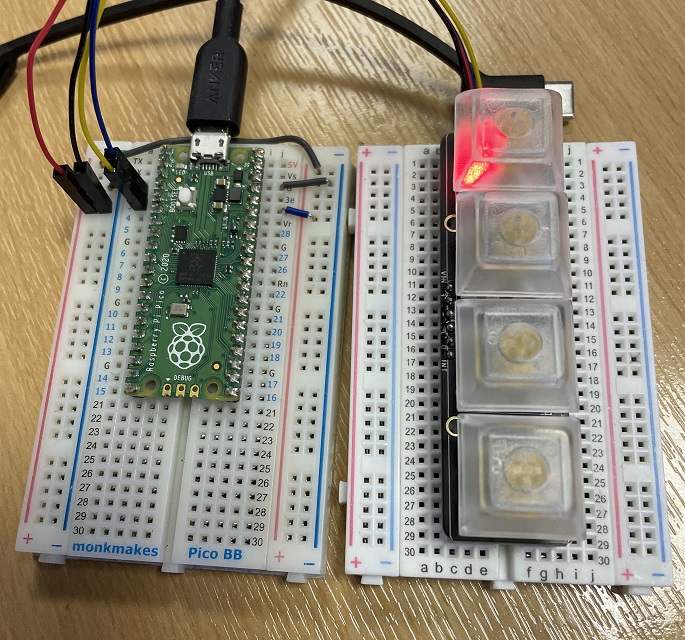Raspberry Pi Pico
Neokey x 4 Mini Macropad
Adafruit came up with the Neokey. It combines a hot swappable socket for a mechanical keyboard switch with a neopixel for the LED. The x4 board has 4 of them on a board and is controllable over I2C.
In this photograph, I am using the stemma QT socket on the board to connect to the breadboard. I have an adapter that does that. I have soldered some headers to the board but I am just using the second breadboard for stability. With some creativity, this would be quite quick and easy to mount inside some sort of box or tin.

The connections I made were,
- Power to 3V3
- GND to GND
- SDA to GP2
- SCL to GP3
This project needs some libraries to be downloaded and added to the libs folder on the Pico. The following links are correct at the time of publishing. Using the latest version of CircuitPython, download the zip for the .mpy version of the library. When you unzip that, you will find a folder with the library name. Copy it to the libs folder on your Pico.
This program does everything that the LED Button Keypad did, just with mechanical switches and neopixels for the LEDs.
import board
import busio
import time
import usb_hid
from adafruit_neokey.neokey1x4 import NeoKey1x4
from adafruit_hid.keyboard import Keyboard
from adafruit_hid.keyboard_layout_us import KeyboardLayoutUS
from adafruit_hid.keycode import Keycode
from adafruit_hid.consumer_control import ConsumerControl
from adafruit_hid.consumer_control_code import ConsumerControlCode
kbd = Keyboard(usb_hid.devices)
layout = KeyboardLayoutUS(kbd)
cc = ConsumerControl(usb_hid.devices)
# specify I2C pins
i2c_bus = busio.I2C(board.GP3, board.GP2)
# Create a NeoKey object
neokey = NeoKey1x4(i2c_bus, addr=0x30)
held = [0]* 4
while True:
if neokey[0]:
neokey.pixels[0] = 0xFF0000
if not held[0]:
# writing text and timing
layout.write("A message.\n")
time.sleep(1)
for c in "This is a message for you.":
layout.write(c)
time.sleep(0.2)
layout.write("\n")
held[0] = 1
elif neokey[1]:
neokey.pixels[1] = 0x00FF00
if not held[1]:
# send a load of key strokes
kbd.send(*[Keycode.SHIFT, Keycode.M, Keycode.ENTER])
held[1] = 1
elif neokey[2]:
neokey.pixels[2] = 0x0000FF
if not held[2]:
cc.send(ConsumerControlCode.VOLUME_INCREMENT)
held[2] = 1
elif neokey[3]:
neokey.pixels[3] = 0xFFFF00
if not held[3]:
cc.send(ConsumerControlCode.VOLUME_DECREMENT)
held[3] = 1
else:
# mark the buttons as not pressed
held = [0] * 4
# clear the colours
for i in range(4):
neokey.pixels[i] = 0x0
# wait a little bit
time.sleep(0.1)

